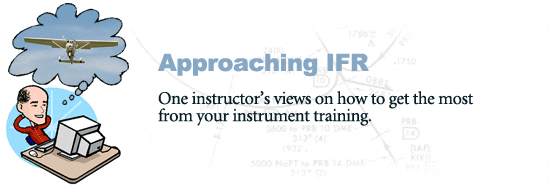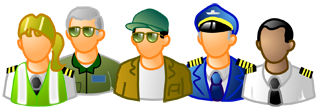
Congratulations!
Make
no mistake about it--statistically, having an IFR rating makes you
a safer and more capable VFR pilot. Congratulations for stepping up
to the challenge ..
But
wait a minute - I said VFR - what's that all about?
I want to scare you a little bit ...
To
put a little "healthy fear" into them, I tell my students
beginning IFR training this: under normal VFR, once you have achieved
a certain level of competence, you pretty much have to go out of your
way to hurt yourself. You have to actively engage in bad judgment,
for example, to run out of fuel or to do "ground reference maneuvers"
over your family barbecue at 100 feet. If you fly reasonably well
and your aircraft is in good shape, VFR flying is a safe activity.
Under IFR (and especially in IMC), on the other hand, encroaching
danger is the default position - you must actively ward off trouble
to get home in one piece.
While
this may be a bit of an overstatement, I hope the basic point is made--flying
IFR is in many ways a whole different ballgame. Any IFR instructor
will teach you how to fly approaches and holds and all that other
good stuff. Good IFR instructors will teach you to think and act systematically--using
checklists (both mental and written) for virtually every action, minimizing
body movements (to ward off vertigo), and maximizing cockpit-resource-management
coordination. For that one day when it's raining sideways inside the
clouds and your inner ear is telling you that left and down are up
and the instruments seem to be saying funny things you need to have
a systematic basis to fall back on. If you run across an instructor
who sets up for an approach by looking for a plate and then setting
the instruments and radios as he/she sees fit in no particular order,
fire that instructor.
I
once had the privilege of flying a Cessna 182 that was owned by a
gentleman who never flew it but needed to keep it from rusting. I
say "once" because I only got to fly it once--a fellow instructor
who also flew it managed to put it into the top of a radio tower in
the fog a few days later on an NDB approach. They found the ADF set
to a reversed heading--075 instead of 057 or something of that sort.
I suspect that he did not have a systematic means for checking and
rechecking his inputs.
Approaching IFR Training the right way ...
Yes,
there's a lot of little things to learn when flying IFR. Despite what
people think, however, it's actually far less than under VFR. You
should already know, say, the aircraft systems plus or minus a review
and re-emphasis on the failure modes of aircraft instruments. And,
as it turns out, flying the aircraft under the hood isn't that difficult,
either, for most people. Yes, it takes practice, but the difficulty
in flying is not the hands and feet actions, it's getting the right
mental picture and thinking systematically. It usually happens suddenly
with my students--after however many lessons it is to listening to
me drone on about systematic thought and action and sort-of-doing-it-but-not-really
but having reached a plateau of sorts listening to my rebukes of "altitude
... heading ..." as they fumble about reading an approach plate
or panic after realizing that they didn't start the timer on a holding
leg, one day they go home, study a bit, and it just turns on. At that
point, I am confident that my students are getting very close to being
ready for their checkride.
Consider
IFR as a series of building blocks. The right way to do it is like
so:
- Fly
VFR properly. If you don't have the experience to
- Land
in a 10-knot crosswind
- Talk
to approach controllers (VFR)
- Transition
class B airspace
without
consternation, you're not ready for IFR training.
There's nothing stopping you from getting additional VFR instruction
from an instructor. While there are certainly many pilots with much
more experience than I, I do have all my instructor ratings and
teach regularly yet I still seek VFR instruction in ordinary airplanes
from time to time.
The FAA has a number of boneheaded rules. However, the Part 61
requirement of 50 cross country hours before IFR is not one of them.
Use that time, spread out over six months to one year to challenge
yourself.
I turn away all students with fresh Private Pilot certificates
(I generally require at least 35xc before accepting a new instrument
student) who want to jump right into the flying part of IFR training.
While such students have all the right enthusiasm and safety-conscious
motives in their heads--they're just not ready yet. Of course, some
don't listen and find some other instructor who lets them do 50
hours of VFR cross country flying concurrently with their IFR training.
Few are successful in this approach. I suspect that far fewer still
are good IFR pilots.
A better approach is to do the IFR bookwork (step 2 below) while
doing your 50 hours of cross country flying. Ideally, your cross-country
flying should include flights to not less than 20 different airports
of all types.
- Learn
everything you can about IFR on the ground. Fly using Microsoft Flight
Simulator or your other favorite sim Take your knowledge (written)
test as soon as you can.
- Show
up to fly. Learn to fly headings and altitudes precisely under the
hood.
- Spend
a lot of time with your instructor ON THE GROUND learning his particular
systematic approaches to flying. These may include some of the mnemonics
which I have listed on this
page. I ask my students to write a "script" for IFR
flights in this time, consisting of, say, a number of approaches.
I ask them to make the script as detailed as possible and I correct
it with them so that the student really understands what I want. If
your instructor doesn't ask you to do this--why not ask him? You will
also have the benefit of looking at this script in the future when
things fade from your memory. Such scripts are typically 15+ pages
long!
- Practice
approaches and holds at home on the sim. When you get good at this,
fly them in a 737 if you have to such that things are twice or more
as fast as usual. Practice approaches and holds in the airplane with
your instructor. Put your life outside of IFR on autopilot for a few
weeks. If you do not or can not do this, expect substandard results.
Read up on IFR stuff using a textbook. Practice, practice, practice
on the sim. Where three degrees was good enough yesterday, one degree
is the target today. When you know the theory, you can concentrate
on the flying.
- Do
the requisite cross countries, in IMC, if possible. IMC is something
rather different than being under the hood! Fall back on your systematic
training.
- Take
the checkride. The best compliments I get are reports of how easy
the IFR checkride is.
Judgment
I know
I sound like a bit of a hard-ass here when describing IFR training.
This is intentional mainly to give you a sense that it is (or should
be) serious business. That said, IFR training can be a lot of fun (in
fact, it's my personal favorite sort of training to give). One nice
thing about it is that, if you find a willing instructor, you can do
it at night or early in the morning more or less around your daily life
(though expect to get little actual work done at work during your training.)
Yes, it's legitimately possible to finish an IFR rating in about 20-30
hours (remember, the FAA minimum is 15 hours with a CFII--the other
required simulated instrument time can be done under the hood with a
safety pilot) and I have seen safe competent pilots accomplish this
where others languish at 60+ hours, never really getting it.
Lastly,
I'd be remiss if I didn't mention something about judgment. I want to
share a story with you from a former student.
|
"I knew it was going to be a rough day. I got up at 5:30, rushed
to the airport, quickly filed to XXX and took off in the Arrow. Was
in the clouds at 1000 feet and the whole 1.5 hour flight was in solid
IMC with moderate turbulence. I got to XXX and immediately transferred
to a waiting car where I had a 30-minute pre-meeting with my team. We
arrived at the meeting 15 minutes late because of traffic, and the actual
meeting went on for 5 intense hours. After it was done, I had to have
a business dinner and, after another long car ride, was back at the
airport. The weather had worsened. Nevertheless, I took off. You can
imagine how exhausted I was at this point! About half an hour into the
flight, while near (major NYC airport), I started to get serious vertigo.
I couldn't tell which way was up. I flew the airplane per our training--it
took every ounce of my remaining concentration just to maintain straight
and level--without the training I don't think I would have even been
able to do that. Yet, I managed to make a non-precision approach, now
at night, to minimums without any problem. How did I do it?"
|
The answer
that my student gave was this--anticipating the stressful day he was going
to have, he, already a 1000-hour pilot, took along a co-pilot--an ATP
rated friend, for the whole trip. When things got bad, the friend took
over. This is the embodiment of judgment. I hope that I can live up to
my student's good judgment of the day. I hope, when you get the rating,
you do too.
|
Duck
and Cat Instrument Flying
Most people wish to fly on the old gauges at one time or another
but are prevented by the high cost of the instruments necessary
for this form of flight. The following is a more or less known and
extremely simple method which may be used by all.
Place a live cat on the cockpit floor, because
a cat always remains upright, he or she can be used in lieu of a
needle and ball instrument. Merely watch to see which way he leans
to determine if a wing is low and if so, which one. This will enable
you to your aircraft level in route with complete accuracy and confidence.
A duck is used for final instrument approach and
landing, because of the fact that any sensible old duck will refuse
to fly under instrument conditions, it is only necessary to hurl
your duck out of the cockpit window and follow her to the ground.
There are some limitations on the cat and duck
method, but by rigidly adhering to the following check list a degree
of success will be achieved which will not only startle you, but
will astonish your passengers as well, and may have an occasional
tower operator with an open mouth.
· Get a wide-awake cat, most cats do not
want to stand up all the time, so it may be necessary to carry a
fierce dog along to keep the cat at attention.
· Make sure your cat is clean, dirty cats
will spend all the time washing. Trying to follow a washing cat
usually results in a slow roll followed by an inverted spin. You
will see that this is most unprofessional.
· Old cats are the best, young cats have
nine lives, but an old used up cat with only one life left has just
as much to loose and will be more dependable.
· Avoid stray cats. Try to get one with
good character because you may want to spend time with her.
· Beware of cowardly ducks, if the duck
discovers that you are using the cat to stay upright, she will refuse
to leave the aeroplane without the cat. Ducks are no better on instruments
than you are.
· Get a duck with good eyes. Near sighted
ducks sometimes fail to recognise that they are on the old gauges
and will go flogging into the nearest hill. Very near sighted ducks
will not realise that they have been thrown out and will descend
to the ground in a sitting position. This is a most difficult manoeuvre
to follow in an airplane.
·
Choose your duck carefully, it is easy to confuse ducks with geese.
Many large birds look alike. While they are very competent instrument
flyers, geese seldom want to go in the same direction that you do.
If your duck seems to be taking a heading to Ireland or Sweden,
you may be safe in assuming that someone has given you a goose.
|
Conclusions
I hope
I have given you a tough but fair introduction to how you might want
to think about IFR training. If you have additional concerns, please
don't hesitate to contact us by submitting a ticket via our
helpdesk system.
As always,
we very much appreciate if you consider our software for your FAA knowledge
test prep needs. We are a small company and greatly appreciate your
business.
Blue Skies,

JG, FAA Gold Star CFI
Over 15500 hours of Flight Instruction Given (as of January 2026)
Loves to Fly!
Part of The Dauntless Instructor / Editorial Team
|

